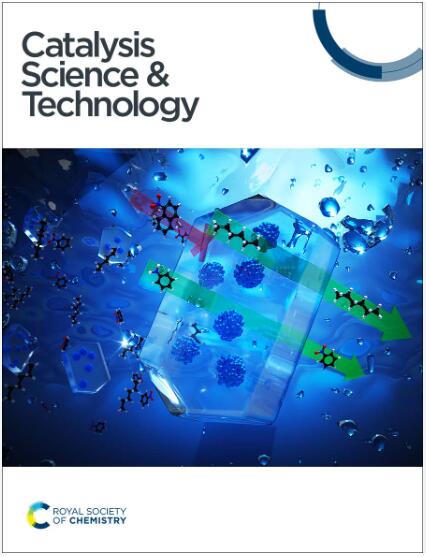丙酸在Fe-MFI沸石上的选择性酮化:酸强度和密度的关键作用
IF 4.2
3区 化学
Q2 CHEMISTRY, PHYSICAL
引用次数: 0
摘要
酮化反应提供了一种方便的方法来去除氧,增加羧酸的碳链长度而不消耗H2。具有强Brønsted酸位(BAS)的传统沸石对酮化反应非常活跃;然而,由于在强BAS上容易发生二级和三级反应,它们具有低酮选择性和快速失活。本文制备了一系列具有较弱BAS (Fe- oh - Si)的Fe- mfi分子筛(Si/Fe = 80-180),对其进行了表征,并在350℃常压下进行了丙酸酮化实验。与Al-MFI-180相比,Fe-MFI-180的BAS强度较弱,虽然适度降低了丙酸酮化反应的活性(TOF分别为6.97和3.80 min−1),但显著降低了二级(醛醇缩合)和三级(芳烃生成)反应的活性(3-戊酮转化TOF分别为1.85和0.33 min−1),使3-戊酮成为主要的一级产物,并提高了稳定性。与具有强BAS的Al-MFI相比,Fe-MFI分子筛不仅表现出较高的TOF (2.00-3.80 min−1),而且提高了对3-戊酮的选择性和稳定性。研究结果表明,可以通过降低沸石的BAS强度来降低二级和三级反应的活性,从而提高羧酸酮化反应的选择性和稳定性。本文章由计算机程序翻译,如有差异,请以英文原文为准。
Selective ketonization of propionic acid on Fe-MFI zeolites: crucial roles of acid strength and density†
The ketonization reaction offers a convenient approach to remove oxygen and increase the carbon chain length of carboxylic acids without consuming H2. Conventional zeolites with a strong Brønsted acid site (BAS) are very active for ketonization; however, they suffer from low ketone selectivity and fast deactivation owing to the facile secondary and tertiary reactions occurring on the strong BAS. Herein, a series of Fe-MFI zeolites (Si/Fe = 80–180) with a weaker BAS, i.e., Fe–OH–Si, than Al-MFI were prepared, characterized and tested for ketonization of propionic acid at 350 °C and atmospheric pressure. Compared with Al-MFI-180, although Fe-MFI-180 with its weaker BAS strength moderately reduces the activity for propionic acid ketonization (turnover frequency (TOF) of 6.97 and 3.80 min−1, respectively), it significantly reduces the activity of secondary (aldol condensation) and tertiary (aromatics formation) reactions (3-pentanone conversion TOF of 1.85 and 0.33 min−1, respectively), resulting in 3-pentanone as the dominant primary product as well as improved stability. The Fe-MFI zeolites not only showed high TOF (2.00–3.80 min−1) but also improved the selectivity for 3-pentanone and enhanced stability compared to Al-MFI with strong BAS. These results demonstrate a strategy for weakening the strength of BAS of zeolites to reduce the activity of the secondary and tertiary reactions and thereby improve the selectivity and stability of ketonization of carboxylic acids.
求助全文
通过发布文献求助,成功后即可免费获取论文全文。
去求助
来源期刊

Catalysis Science & Technology
CHEMISTRY, PHYSICAL-
CiteScore
8.70
自引率
6.00%
发文量
587
审稿时长
1.5 months
期刊介绍:
A multidisciplinary journal focusing on cutting edge research across all fundamental science and technological aspects of catalysis.
Editor-in-chief: Bert Weckhuysen
Impact factor: 5.0
Time to first decision (peer reviewed only): 31 days
 求助内容:
求助内容: 应助结果提醒方式:
应助结果提醒方式:


